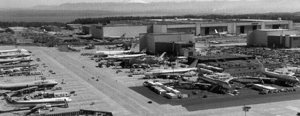 In 1980, Kryton invented the first crystalline concrete waterproofing admixture, calling it Krystol Internal Membrane (KIM). The initial discovery was that it retarded the concrete, reduced set-time and added waterproofing properties throughout the entire concrete structure.
In 1980, Kryton invented the first crystalline concrete waterproofing admixture, calling it Krystol Internal Membrane (KIM). The initial discovery was that it retarded the concrete, reduced set-time and added waterproofing properties throughout the entire concrete structure.
Around this same time, the Austin Engineering Company was doing research for the US Navy regarding the reconditioning of the Navy dry docks in Bremerton, Washington. They recommended the use of the Krystol products to waterproof the new facility.
A few years later, in 1983, Boeing (going on Austin’s previous recommendation), used KIM in the below grade tunnels of the facility they were expanding to produce 777s. The original facility was designed, engineered and constructed by Austin in 1966 and was already the largest building by volume in the world. They had pits and wells that were 4 ft.-6 ft. thick. Austin dug 6,500 feet of tunnels to accommodate utility mains and designed for emergency evacuation, and 11,500 feet of trenches to facilitate utility installation. The system continues to perform perfectly today.
 As a result of this success, Krystol Internal Membrane has been used in thousands of projects since, including: US Navy yards and Army bases in Hawaii, Korea and Diego Garcia; Marina Bay Sands in Singapore; and CityCenter in Las Vegas. KIM continues to stand up to the test of time, and offers the industry-leading 25-year warranty, with many projects such as this outliving this warranty by many years.
As a result of this success, Krystol Internal Membrane has been used in thousands of projects since, including: US Navy yards and Army bases in Hawaii, Korea and Diego Garcia; Marina Bay Sands in Singapore; and CityCenter in Las Vegas. KIM continues to stand up to the test of time, and offers the industry-leading 25-year warranty, with many projects such as this outliving this warranty by many years.
At the time of constructing the Boeing tunnels, sheet membranes had an average life expectancy of only five years, which would mean Boeing would have had to do replacements or repairs at least six times since 1983. Can you imagine how much time and money was saved, by waterproofing the structure permanently?






